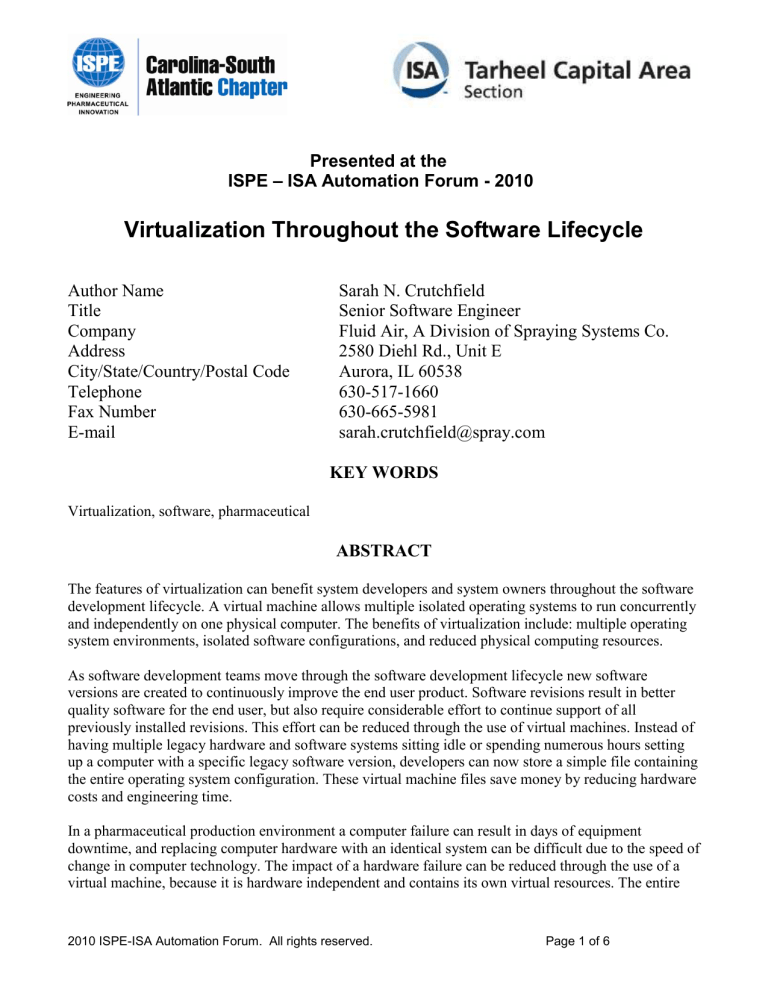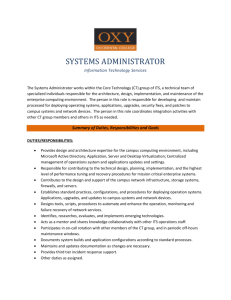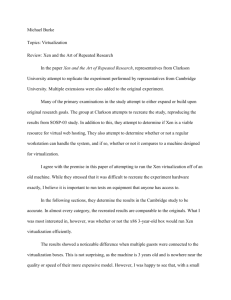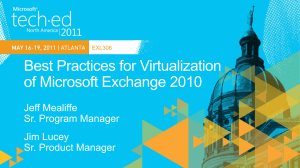Virtualization Throughout the Software Lifecycle

Presented at the
ISPE – ISA Automation Forum - 2010
Virtualization Throughout the Software Lifecycle
Author Name
Title
Company
Address
City/State/Country/Postal Code
Telephone
Fax Number
Sarah N. Crutchfield
Senior Software Engineer
Fluid Air, A Division of Spraying Systems Co.
2580 Diehl Rd., Unit E
Aurora, IL 60538
630-517-1660
630-665-5981 sarah.crutchfield@spray.com
KEY WORDS
Virtualization, software, pharmaceutical
ABSTRACT
The features of virtualization can benefit system developers and system owners throughout the software development lifecycle. A virtual machine allows multiple isolated operating systems to run concurrently and independently on one physical computer. The benefits of virtualization include: multiple operating system environments, isolated software configurations, and reduced physical computing resources.
As software development teams move through the software development lifecycle new software versions are created to continuously improve the end user product. Software revisions result in better quality software for the end user, but also require considerable effort to continue support of all previously installed revisions. This effort can be reduced through the use of virtual machines. Instead of having multiple legacy hardware and software systems sitting idle or spending numerous hours setting up a computer with a specific legacy software version, developers can now store a simple file containing the entire operating system configuration. These virtual machine files save money by reducing hardware costs and engineering time.
In a pharmaceutical production environment a computer failure can result in days of equipment downtime, and replacing computer hardware with an identical system can be difficult due to the speed of change in computer technology. The impact of a hardware failure can be reduced through the use of a virtual machine, because it is hardware independent and contains its own virtual resources. The entire
2010 ISPE-ISA Automation Forum. All rights reserved. Page 1 of 6
validated computer configuration is wrapped neatly into one file that can be copied for storage and placed on a new computer in the event of a hardware failure, reducing risk and revalidation efforts.
This presentation not only introduces the audience to system virtualization technology, but also provides specific applications in which this technology benefits system developers and pharmaceutical industry end users.
2010 ISPE-ISA Automation Forum. All rights reserved. Page 2 of 6
INTRODUCTION
Advances in computer technology create unique challenges and benefits for the pharmaceutical industry.
The amount of time and money required to qualify any changes to a pharmaceutical application can discourage users from taking advantage of technological advances, but the risk of continuing to produce product on older systems increases each year as computer and software technologies are abandoned in favor of the latest technology. The aging control systems also create a difficult situation for software providers who struggle to support their older installations and develop new innovative products.
Virtualization can not only decrease the risk associated with running older software systems, but also help equipment providers to support and service these systems without sacrificing innovation. The purpose of this white paper is to reveal the benefits virtualization can provide to both the customer and software provider through various stages of the software lifecycle.
VIRTUALIZATION BACKGROUND
A virtual machine replicates all the components of a physical computer, including hardware and software, to allow multiple fully functional virtual computers to run on a single host computer. The virtual machine runs independent of the host system, providing a layer of abstraction between the physical hardware and virtual hardware. This independence from the physical hardware makes it simple to move and copy virtual machines between physical machines. Replicating a virtual machine ensures the same base operating environment can be utilized across various physical and/or virtual systems.
SOFTWARE LIFECYCLE
Software goes through several phases from the initial design to obsolescence. The GAMP software life cycle includes the following phases: Concept, Project, Operation, and Retirement [GAMP 5 26]. During the Concept phase, requirements are defined to evaluate whether a software package is a viable solution.
At this point the undertaking may be abandoned or proceed to the Project phase, where the specification is further defined and the software is developed and tested against the specification. Once the software is released it proceeds to the Operation phase, which may involve changes over time to improve or add functionality. The system will remain in the Operation phase until it is decided that it no longer fulfills the required needs and must transition to the Retirement phase. At this time the system is removed from production or replaced, but access to the system may still be required to retain batch data.
SOFTWARE SUPPLIERS
Software suppliers should be involved throughout the life of the product. The supplier’s role during
Operation is to provide support to the customer and possibly implement any required changes. It can be a challenge to support systems that operate on obsolete hardware, but virtualization can be used to overcome this challenge. The benefits of virtualization that can be realized by the software supplier during the Project and Operation phases are listed in the following table.
Virtualization Feature Benefit for System Providers
Ease of replication Setup time for development and system computers is
2010 ISPE-ISA Automation Forum. All rights reserved. Page 3 of 6
reduced, because virtual machines can be easily copied between systems.
Copying virtual machine ensures the correct base configuration, which increases quality.
Virtual machines can be configured for each software revision to allow easy access.
Hardware and operating system independent
Customer virtual machines can be run on any development computer, allowing developers to see exactly what the customer sees.
A virtual machine of a legacy system can run on modern host computers and operating systems.
Fluid Air has utilized virtual machines to provide multiple development environments with various revisions of software development tools. This saves time when testing out new development software revisions; if the newer revision doesn’t function as expected the previous revisions is still installed on a different virtual machine. Changing the revision on a physical system can require numerous uninstalls and reinstalls.
Virtualization can also improve quality procedures when releasing the system to the customer. Fluid Air previously had several pages of instructions to ensure a system was set up correctly. These procedures included configuring the operating system, installing applications and placing files on the system. Now the base configuration is all contained in a virtual machine. The VM player is installed on the computer and the virtual machine files are copied onto the system. Once the virtual machine is started a few configuration files can be replaced to set up the specific system. As a result, computer setup time has decreased from eight hours to one hour, and reducing the manual tasks has increased the system quality by decreasing human error.
SOFTWARE OWNERS
A pharmaceutical control system installation should provide numerous years of stable operation that far exceed the initial investment. When operations are running smoothly it can be easy to proceed without thought of replacing the aging system, but operations can come to a screeching halt should a failure occur and the failed part is no longer readily available. When dealing with an industry that changes as fast as computer technology, users must plan for failure of hardware that is no longer available.
Performance improvements, new technology, and software releases can make the previous technology obsolete and unavailable. When the hardware or software cannot be sourced, the only solution is to move to the latest platform. This can result in an undesirable amount of down time while new solutions are developed, installed and qualified. Running control system software through a virtual machine isolates it from the host hardware and operating system, resulting in the benefits in the following table.
Virtualization Feature Benefit for System Owners
Ease of replication The virtual machine can be copied and stored in a secure location for disaster recovery.
2010 ISPE-ISA Automation Forum. All rights reserved. Page 4 of 6
Hardware and operating system independent
A new computer can be quickly set up and revalidated in the event of a failure.
The system provider can have access to an exact copy of the virtual machine to improve support and troubleshooting.
A virtual machine running a legacy control system can have a longer life with the ability to run on modern computer hardware.
Some pharmaceutical production control systems are at risk due to the limited availability of older software and hardware. If these systems experience a failure the result could be weeks of downtime to recreate a stable system and validate. Fluid Air’s Factrol batch control software was developed to run on a Windows NT or XP operating system and a Pentium4 processor. Microsoft continues to make XP available to computer manufacturers, but this highlights the vulnerability of these production control systems to technology software and hardware providers.
Current Fluid Air Batch Architect Pro systems should be free from this type of vulnerability in the future due to the utilization of virtual machines. The virtual machines are configured with a single core processor running Windows XP, and the host computer has a dual core processor running Windows 7.
Regardless of technological advances, these systems will be protected in the future because they can be transferred to any host operating system and hardware configuration.
SUMMARY
Each of us has personally experienced how technology can both enhance our lives and make them more difficult. The same relationship with technology exists in the pharmaceutical industry. Companies strive to continue running their processes on stable, qualified systems, while technology forges ahead making yesterdays hardware obsolete. Unfortunately, these innovations and improvements mean change for legacy pharmaceutical software installations, but the pain associated with these changes can be lessened by utilizing virtualization technology.
When applied in the pharmaceutical industry virtual machines can provide benefits to software suppliers and owners throughout the product life cycle. Virtualization can ultimately result in less downtime, lower costs, and decreased business risk for software owners by extending the software product life cycle and reducing disaster recovery efforts. System suppliers can benefit from virtualization through lower operating costs, improved efficiency, and the ability to provide better customer support.
2010 ISPE-ISA Automation Forum. All rights reserved. Page 5 of 6
REFERENCES
GAMP 5 A Risk-Based Approach to Compliant GxP Computerized Systems (ISPE, 2008)
© 2010 Fluid Air, A Division of Spraying Systems Co.
2010 ISPE-ISA Automation Forum. All rights reserved. Page 6 of 6





